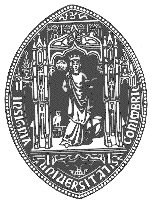9th
European Intensive Course on Complex Analysis
“Complex Analysis and its Generalizations (with applications to partial differential equations)” |
|
Departamento de Matemática,
Universidade de Coimbra, Portugal
|
This intensive course will have a total of 40 hours of lectures and is at postgraduate level. Lecturers will have time available to discuss with the students. Successfully participating students will get a certificate. This course is organized by the Universities of Coimbra and Aveiro with the same goals as the ones organized under the programme Socrates, and is open to all young mathematicians interested in Complex Analysis and its applications.
There will be an
Workshop
on "Applications and Generalizations of Complex Analysis" on the 15th
of March. ![]()
|
10 March |
11 March |
12 March |
13 March |
14 March |
|
|
Opening session |
9h30m-10h |
* |
* |
* |
* |
|
10h-12h30m |
10h-12h30m |
10h-12h30m |
10h-12h30m |
||
|
14h30m-17h |
14h30m-17h |
|
14h30m-17h |
14h30m-17h |
|
17 March |
18 March |
19 March |
20 March |
21 March |
|
|
10h-12h30m |
10h-12h30m |
10h-12h30m |
14h30m-17h |
||
|
14h30m-17h |
14h30m-17h |
|
14h30m-17h |
10h-12h30m |
HERMITE-PADÉ APPROXIMATION AND MULTIPLE ORTHOGONAL POLYNOMIALS
- Walter Van Assche (Katholieke Universiteit Leuven, Belgium)
Contents: Hermite-Padé approximation is simultaneous rational approximation of a vector (f1, … ,fr) of r functions with interpolation conditions at a given point in the complex plane. In this course the following aspects will be covered:
ELEMENTS OF QUATERNIONIC ANALYSIS AND
RADON TRANSFORM -
Jarolim Bures and Vladimir Soucek (Charles University, Czech Republic) Abstract: The presented series of lectures offers a
description of basic facts of quaternionic analysis. We shall describe
properties of solutions of the Fueter equation and its third power. The second
topic of the series will be the Radon transform, its inversion and its
applications for study of quaternionic functions in quaternionic analysis.
Refernces:
FUNCTION SPACES IN CLIFFORD ANALYSIS -
Uwe Käehler
(Universidade de Aveiro, Portugal) Contents: Prerequisits (not necessary, but recommendable): Refernces: - Fernando
Chamizo (Universidad Autonoma de Madrid, Spain) Abstract: This course aims to give a proof of the Prime Number
Theorem with error term emphasizing the use of Complex Analysis. We shall also
discuss some other results and problems in Number Theory related to Complex
Analytic thechniques. In particular the original formulation to the so called "circle
method"due to Hardy and Littlewood. Probably lectures notes will be available to the participants at the
beginning of the course. References: This intensive course follows the seven held in Coimbra and Aveiro from
1995 to 2002
and there are plans for intensive courses in the following
years. The lecture
notes
of some of the courses have been published in Coimbra and others are
in print.
Helmuth Malonek
(Departamento de Matemática da Universidade
de Aveiro)
J. Carvalho e Silva
(Departamento de Matemática Universidade de Coimbra)
Amilcar Branquinho
(Departamento de Matemática Universidade de Coimbra)
Living expenses can be partially covered for some students if they do
not have support from their own institution and if there is enough money
available.
![]()
![]()
.
![]()
History
![]()
Organizers
![]()
Financial Support
![]()
With
support from
CMUC
(Centro de
Matemática da Universidade de Coimbra), UI&D "Matemática e Aplicações" da
Universidade de Aveiro, and the Socrates programme

